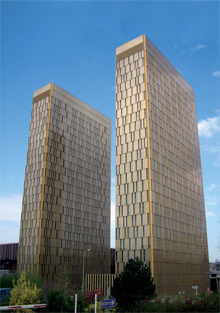You are in:
- Start
- Articles
- What is the Court of Justice of the European Union for?
What is the Court of Justice of the European Union for?MISCELLANEOUS
Gregorio Robles.
Professor in Philosophy of Law at the University of the Balearic Islands
Member of the Royal Academy of Moral and Political Sciences
Court of Justice of the European Union or the Luxembourg Court
However much the media may talk all the time about the European Union and its institutions, the average citizen sees them as something remote, as a large and rather strange bureaucratic structure hiding behind a fog of barely comprehensible acronyms. Politicians have too much verbiage when criticising their opponents and not enough education, which is something we all need in order to find our way around this highly complex world of ours.
I say this because I am sure that you will have heard of the Court of Justice of the European Union sometime –who has not? But do you really know what it is for? You have to admit that, even unconsciously, you have come to believe that it cannot be particularly useful– I would even venture to say that you do not exactly recall which city it is based in. Is it Brussels? Strasburg? Frankfurt? Or Luxembourg?
Well, the Court of Justice of the European Union is in fact based in Luxembourg, that rather misty city which is the capital of that small country of the same name. That is why the Court of Justice is also known as the Luxembourg Court – even though that is not its official name.
The Court of Justice of the European Union is based in Luxembourg, which is why it is usually called the Luxembourg Court – even though that is not its official name
Strasbourg Court or Court of Human Rights
It is very important to remember this fact, as people tend to confuse it with the Court in Strasbourg, a city which, as you well know, is the capital of Alsace, a region which today belongs to France but was formerly part of Germany. The Strasbourg Court is an institution not of the EU but of the Council of Europe, which is an international organisation currently made up of no less than 47 European countries. The Strasbourg Court, also known as the Court of Human Rights, forms part of the Council of Europe (not to be confused with the Council of the European Union). Its task is to apply the Rome Convention of 1950 to litigants (i.e. those having recourse to the Court demanding justice) after plaintiffs have exhausted all legal remedies within their own country. That is what happened in the case of a well-known Spanish businessman who went to court to defend his rights before the Spanish courts and, once all legal avenues in Spain had been exhausted, went to the Strasbourg Court, which agreed with him. The trouble is that, right now the judgments of this Court are not enforceable, even though they do have moral relevance or, to use a term which is very much in vogue in some countries, they constitute “soft law”. I do not intend to talk about this Court here, even though it was necessary to make this footnote to clearly distinguish it from the Luxembourg Court.
It is currently made up of 27 judges, who are appointed by mutual agreement by the governments of the states for a period of six years and are assisted in their tasks by eight “Advocates-General”
How is the Court of Justice of the European Union structured?
The Court of Justice of the EU is currently made up of 27 judges, one for each Member State. These judges are appointed by mutual agreement by the governments of the states for a period of six years. They are assisted in their tasks by eight “Advocates-General” whose basic job is to submit studies –on whatever matters the Court may require– as opinions in which, after analysis of the facts and fundamental points of law, the solution to the case is proposed. These studies are known as “submissions of the Advocate- General” and are published with the name of the Advocate-General who has made them. However, they are not binding on the Court, although in practice the Court does usually follow the recommendations they contain. The Advocates-General form part of the Court of Justice’s organisational structure.
The Court’s basic tasks are as follows:
- To check that the acts of the Community institutions (Council, Commission) are legally admissible, which is why provision is made for various remedies, particularly the so-called rescissory action, the purpose of which is to annul any Community actions which overstep the mark as regards what Community law allows.
- To check that the Member States meet their obligations. To this end, various procedural remedies are provided for, outstanding among which is action for the failure of States to fulfil their obligations.
- To ensure the uniform application and interpretation of Community law throughout the European Union. This function is of great importance. The Court is said to have a “monopoly on the interpretation” of Community law, which means that it has the last word on any question that arises relating to how a specific provision is to be interpreted. It is also competent to declare invalid any Community provisions which are incompatible with or contradictory to the Treaties.
- To go more deeply into the development of rules of Community law, covering possible “gaps”, resolving any contradictions, and clarifying rules which the Treaties assume but do not formulate explicitly.
As you can see, these are extensive and very important tasks. Hence the enormous importance of the Court of Justice, which has been rightly called the “legal engine” of European integration.
The Court has a “monopoly on the interpretation” of Community law when any question arises relating to how a specific provision is to be interpreted
Implications for European citizens
From the point of view of private individuals like you and me, and also as far as companies are concerned, it has to be borne in mind that the vast majority of matters that can affect us are conducted before national judges – in our case before Spanish judges. In other words, it is the national judges who form the ordinary jurisdiction in the application of European law. This makes sense: imagine what it would be like if the Luxembourg Court had to resolve all the questions of individuals and companies.
Spanish judges apply Community law because it is also Spanish law. This is what is meant when we say that European law is integrated into national law. In effect, it becomes part of national law.
So, if you or your company have a lawsuit in Spain in which rules of Community law have a bearing, the Spanish judge will be the one charged with applying theses rules to the case. However, it may be that the Spanish judge has some doubt as to how to interpret a word, a concept or a phrase in the European legal provision that he has to apply. It may also happen that he has doubts as to whether a Spanish law is compatible or not with the requirements of European law. In order to resolve these doubts, provision is made for a “mechanism of dialogue” between the Spanish judge (or judge of any other of the 27 nationalities) and the Luxembourg Court.
This “mechanism of dialogue” consists of the following: the national judge, faced with the perplexing situation in which he finds himself through not knowing exactly what scope to give to a Community provision, interrupts the case he is hearing and contacts the European Court, setting out the questions he wishes in order to resolve the doubts he has. Once the Court of Justice has replied, he will be able to continue with the case and apply the Community rules free of the doubts he had.
The Court’s judgments are published periodically in the Reports of Cases before the Court and are also accessible via the Internet. The classic publication format includes the report of the Judge-Rapporteur (who is the judge making a special study of the matter) and the submissions of the Advocate-General, as well as, of course, the text of the judgment.
This text is generally organised into three parts:
- First, a summary of the facts giving rise to the litigation is given, specifying the type of appeal made by the plaintiff, detailing his or her arguments and the arguments of the defendant. This start to the judgment is usually summarising and descriptive.
- Second, each judgment sets out the reasons used by the Court in the analysis of the case, taking account of the rules in force under Community law and interpreting them in the light of the peculiarities of the particular case and the economic, political and social context in which it arises. This second part is geared to justifying the judgment and also to persuading the community (legal and nonlegal) that the judgment in question is essentially correct.
- Finally, we have the ruling or decision resolving the lawsuit and also specifying who has to pay the costs of the case. The judgment is the logical consequence of all the previous reasonings.
As part of the judgment, the judges sign their names and indicate the date on which the judgment was given a public hearing. Dissenting votes are not recorded, the Court’s decision being collective. The internal discussions belong to the secrecy of deliberations, which the judges have a legal duty to maintain.
Through the “mechanism of dialogue”, a national judge who does not know exactly what scope to give to a Community provision during legal proceedings can interrupt them and contact the European Court
The reality is much more complex
In this article, I have confined myself to setting out the most basic features of the Luxembourg Court. However, the current reality is much more complex. Not only because a Court of First Instance has operated since 1989, but above all because the Treaty of Lisbon of 13 December 2007 (entry into force: 1 December 2009) introduced profound changes in the organisation of the European jurisdictional system.

 Court of Justice of the European Union Headquarters, Luxembourg
Court of Justice of the European Union Headquarters, Luxembourg General view of Luxembourg
General view of Luxembourg


